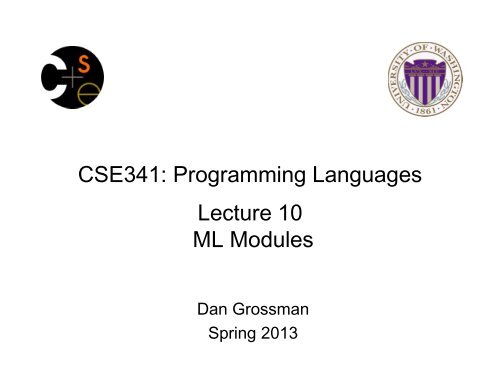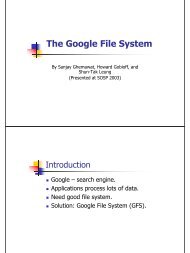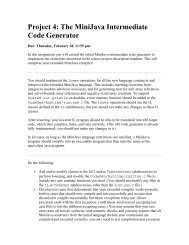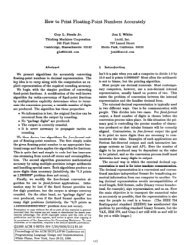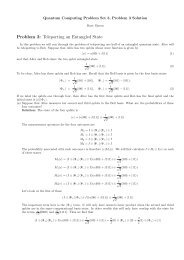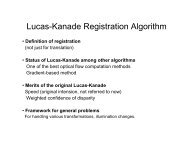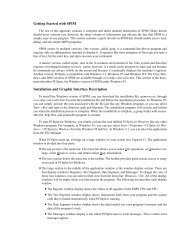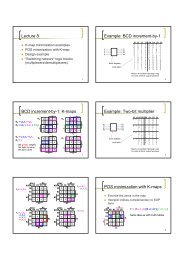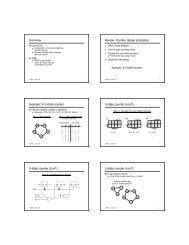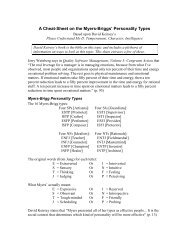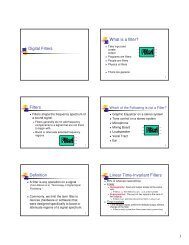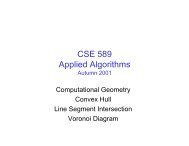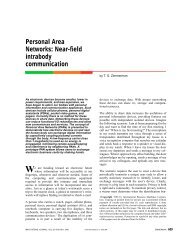int * int -> int * int
int * int -> int * int
int * int -> int * int
You also want an ePaper? Increase the reach of your titles
YUMPU automatically turns print PDFs into web optimized ePapers that Google loves.
CSE341: Programming Languages<br />
Lecture 10<br />
ML Modules<br />
Dan Grossman<br />
Spring 2013
Modules<br />
For larger programs, one “top-level” sequence of bindings is poor<br />
– Especially because a binding can use all earlier (nonshadowed)<br />
bindings<br />
So ML has structures to define modules<br />
structure MyModule = struct bindings end<br />
Inside a module, can use earlier bindings as usual<br />
– Can have any kind of binding (val, datatype, exception, ...)<br />
Outside a module, refer to earlier modules’ bindings via<br />
ModuleName.bindingName<br />
– Just like List.foldl and String.toUpper; now you can<br />
define your own modules<br />
Spring 2013 CSE341: Programming Languages<br />
2
Example<br />
structure MyMathLib =<br />
struct<br />
fun fact x =<br />
if x=0<br />
then 1<br />
else x * fact(x-1)<br />
val half_pi = Math.pi / 2<br />
fun doubler x = x * 2<br />
end<br />
Spring 2013 CSE341: Programming Languages<br />
3
Namespace management<br />
• So far, this is just namespace management<br />
– Giving a hierarchy to names to avoid shadowing<br />
– Allows different modules to reuse names, e.g., map<br />
– Very important, but not very <strong>int</strong>eresting<br />
Spring 2013 CSE341: Programming Languages<br />
4
Optional: Open<br />
• Can use open ModuleName to get “direct” access to a<br />
module’s bindings<br />
– Never necessary; just a convenience; often bad style<br />
– Often better to create local val-bindings for just the bindings<br />
you use a lot, e.g., val map = List.map<br />
• But doesn’t work for patterns<br />
• And open can be useful, e.g., for testing code<br />
Spring 2013 CSE341: Programming Languages<br />
5
Signatures<br />
• A signature is a type for a module<br />
– What bindings does it have and what are their types<br />
• Can define a signature and ascribe it to modules – example:<br />
signature MATHLIB =<br />
sig<br />
val fact : <strong>int</strong> -> <strong>int</strong><br />
val half_pi : real<br />
val doubler : <strong>int</strong> -> <strong>int</strong><br />
end<br />
structure MyMathLib :> MATHLIB =<br />
struct<br />
fun fact x = …<br />
val half_pi = Math.pi / 2.0<br />
fun doubler x = x * 2<br />
end<br />
Spring 2013 CSE341: Programming Languages<br />
6
In general<br />
• Signatures<br />
signature SIGNAME =<br />
sig types-for-bindings end<br />
– Can include variables, types, datatypes, and exceptions defined<br />
in module<br />
• Ascribing a signature to a module<br />
structure MyModule :> SIGNAME =<br />
struct bindings end<br />
– Module will not type-check unless it matches the signature,<br />
meaning it has all the bindings at the right types<br />
– Note: SML has other forms of ascription; we will stick with these<br />
[opaque signatures]<br />
Spring 2013 CSE341: Programming Languages<br />
7
Hiding things<br />
Real value of signatures is to to hide bindings and type definitions<br />
– So far, just documenting and checking the types<br />
Hiding implementation details is the most important strategy for<br />
writing correct, robust, reusable software<br />
So first remind ourselves that functions already do well for some<br />
forms of hiding…<br />
Spring 2013 CSE341: Programming Languages<br />
8
Hiding with functions<br />
These three functions are totally equivalent: no client can tell which<br />
we are using (so we can change our choice later):<br />
fun double x = x*2<br />
fun double x = x+x<br />
val y = 2<br />
fun double x = x*y<br />
Defining helper functions locally is also powerful<br />
– Can change/remove functions later and know it affects no<br />
other code<br />
Would be convenient to have “private” top-level functions too<br />
– So two functions could easily share a helper function<br />
– ML does this via signatures that omit bindings…<br />
Spring 2013 CSE341: Programming Languages<br />
9
Example<br />
Outside the module, MyMathLib.doubler is simply unbound<br />
– So cannot be used [directly]<br />
– Fairly powerful, very simple idea<br />
signature MATHLIB =<br />
sig<br />
val fact : <strong>int</strong> -> <strong>int</strong><br />
val half_pi : real<br />
end<br />
structure MyMathLib :> MATHLIB =<br />
struct<br />
fun fact x = …<br />
val half_pi = Math.pi / 2.0<br />
fun doubler x = x * 2<br />
end<br />
Spring 2013 CSE341: Programming Languages<br />
10
A larger example [mostly see the code]<br />
Now consider a module that defines an Abstract Data Type (ADT)<br />
– A type of data and operations on it<br />
Our example: rational numbers supporting add and toString<br />
structure Rational1 =<br />
struct<br />
datatype rational = Whole of <strong>int</strong> | Frac of <strong>int</strong>*<strong>int</strong><br />
exception BadFrac<br />
(*<strong>int</strong>ernal functions gcd and reduce not on slide*)<br />
fun make_frac (x,y) = …<br />
fun add (r1,r2) = …<br />
fun toString r = …<br />
end<br />
Spring 2013 CSE341: Programming Languages<br />
11
Library spec and invariants<br />
Properties [externally visible guarantees, up to library writer]<br />
– Disallow denominators of 0<br />
– Return strings in reduced form (“4” not “4/1”, “3/2” not “9/6”)<br />
– No infinite loops or exceptions<br />
Invariants [part of the implementation, not the module’s spec]<br />
– All denominators are greater than 0<br />
– All rational values returned from functions are reduced<br />
Spring 2013 CSE341: Programming Languages<br />
12
More on invariants<br />
Our code ma<strong>int</strong>ains the invariants and relies on them<br />
Ma<strong>int</strong>ain:<br />
– make_frac disallows 0 denominator, removes negative<br />
denominator, and reduces result<br />
– add assumes invariants on inputs, calls reduce if needed<br />
Rely:<br />
– gcd does not work with negative arguments, but no<br />
denominator can be negative<br />
– add uses math properties to avoid calling reduce<br />
– toString assumes its argument is already reduced<br />
Spring 2013 CSE341: Programming Languages<br />
13
A first signature<br />
With what we know so far, this signature makes sense:<br />
– gcd and reduce not visible outside the module<br />
signature RATIONAL_A =<br />
sig<br />
datatype rational = Whole of <strong>int</strong> | Frac of <strong>int</strong>*<strong>int</strong><br />
exception BadFrac<br />
val make_frac : <strong>int</strong> * <strong>int</strong> -> rational<br />
val add : rational * rational -> rational<br />
val toString : rational -> string<br />
end<br />
structure Rational1 :> RATIONAL_A = …<br />
Spring 2013 CSE341: Programming Languages<br />
14
The problem<br />
By revealing the datatype definition, we let clients violate our invariants<br />
by directly creating values of type Rational1.rational<br />
– At best a comment saying “must use Rational1.make_frac”<br />
signature RATIONAL_A =<br />
sig<br />
datatype rational = Whole of <strong>int</strong> | Frac of <strong>int</strong>*<strong>int</strong><br />
…<br />
Any of these would lead to exceptions, infinite loops, or wrong results,<br />
which is why the module’s code would never return them<br />
– Rational1.Frac(1,0)<br />
– Rational1.Frac(3,~2)<br />
– Rational1.Frac(9,6)<br />
Spring 2013 CSE341: Programming Languages<br />
15
So hide more<br />
Key idea: An ADT must hide the concrete type definition so clients<br />
cannot create invariant-violating values of the type directly<br />
Alas, this attempt doesn’t work because the signature now uses a<br />
type rational that is not known to exist:<br />
signature RATIONAL_WRONG =<br />
sig<br />
exception BadFrac<br />
val make_frac : <strong>int</strong> * <strong>int</strong> -> rational<br />
val add : rational * rational -> rational<br />
val toString : rational -> string<br />
end<br />
structure Rational1 :> RATIONAL_WRONG = …<br />
Spring 2013 CSE341: Programming Languages<br />
16
Abstract types<br />
So ML has a feature for exactly this situation:<br />
In a signature:<br />
type foo<br />
means the type exists, but clients do not know its definition<br />
signature RATIONAL_B =<br />
sig<br />
type rational<br />
exception BadFrac<br />
val make_frac : <strong>int</strong> * <strong>int</strong> -> rational<br />
val add : rational * rational -> rational<br />
val toString : rational -> string<br />
end<br />
structure Rational1 :> RATIONAL_B = …<br />
Spring 2013 CSE341: Programming Languages<br />
17
This works! (And is a Really Big Deal)<br />
signature RATIONAL_B =<br />
sig<br />
type rational<br />
exception BadFrac<br />
val make_frac : <strong>int</strong> * <strong>int</strong> -> rational<br />
val add : rational * rational -> rational<br />
val toString : rational -> string<br />
end<br />
Nothing a client can do to violate invariants and properties:<br />
– Only way to make first rational is Rational1.make_frac<br />
– After that can use only Rational1.make_frac,<br />
Rational1.add, and Rational1.toString<br />
– Hides constructors and patterns – don’t even know whether<br />
or not Rational1.rational is a datatype<br />
– But clients can still pass around fractions in any way<br />
Spring 2013 CSE341: Programming Languages<br />
18
Two key restrictions<br />
So we have two powerful ways to use signatures for hiding:<br />
1. Deny bindings exist (val-bindings, fun-bindings, constructors)<br />
2. Make types abstract (so clients cannot create values of them or<br />
access their pieces directly)<br />
(Later we will see a signature can also make a binding’s type more<br />
specific than it is within the module, but this is less important)<br />
Spring 2013 CSE341: Programming Languages<br />
19
A cute twist<br />
In our example, exposing the Whole constructor is no problem<br />
In SML we can expose it as a function since the datatype binding in<br />
the module does create such a function<br />
– Still hiding the rest of the datatype<br />
– Still does not allow using Whole as a pattern<br />
signature RATIONAL_C =<br />
sig<br />
type rational<br />
exception BadFrac<br />
val Whole : <strong>int</strong> -> rational<br />
val make_frac : <strong>int</strong> * <strong>int</strong> -> rational<br />
val add : rational * rational -> rational<br />
val toString : rational -> string<br />
end<br />
Spring 2013 CSE341: Programming Languages<br />
20
Signature matching<br />
Have so far relied on an informal notion of, “does a module typecheck<br />
given a signature?” As usual, there are precise rules…<br />
structure Foo :> BAR is allowed if:<br />
• Every non-abstract type in BAR is provided in Foo, as specified<br />
• Every abstract type in BAR is provided in Foo in some way<br />
– Can be a datatype or a type synonym<br />
• Every val-binding in BAR is provided in Foo, possibly with a<br />
more general and/or less abstract <strong>int</strong>ernal type<br />
– Discussed “more general types” earlier in course<br />
– Will see example soon<br />
• Every exception in BAR is provided in Foo<br />
Of course Foo can have more bindings (implicit in above rules)<br />
Spring 2013 CSE341: Programming Languages<br />
21
Equivalent implementations<br />
A key purpose of abstraction is to allow different implementations to<br />
be equivalent<br />
– No client can tell which you are using<br />
– So can improve/replace/choose implementations later<br />
– Easier to do if you start with more abstract signatures (reveal<br />
only what you must)<br />
Now:<br />
Another structure that can also have signature RATIONAL_A,<br />
RATIONAL_B, or RATIONAL_C<br />
Next:<br />
– But only equivalent under RATIONAL_B or RATIONAL_C<br />
(ignoring overflow)<br />
A third equivalent structure implemented very differently<br />
Spring 2013 CSE341: Programming Languages<br />
22
Equivalent implementations<br />
Example (see code file):<br />
• structure Rational2 does not keep rationals in reduced form,<br />
instead reducing them “at last moment” in toString<br />
– Also make gcd and reduce local functions<br />
• Not equivalent under RATIONAL_A<br />
– Rational1.toString(Rational1.Frac(9,6)) = "9/6"<br />
– Rational2.toString(Rational2.Frac(9,6)) = "3/2"<br />
• Equivalent under RATIONAL_B or RATIONAL_C<br />
– Different invariants, but same properties<br />
– Essential that type rational is abstract<br />
Spring 2013 CSE341: Programming Languages<br />
23
More <strong>int</strong>eresting example<br />
Given a signature with an abstract type, different structures can:<br />
– Have that signature<br />
– But implement the abstract type differently<br />
Such structures might or might not be equivalent<br />
Example (see code):<br />
– type rational = <strong>int</strong> * <strong>int</strong><br />
– Does not have signature RATIONAL_A<br />
– Equivalent to both previous examples under RATIONAL_B or<br />
RATIONAL_C<br />
Spring 2013 CSE341: Programming Languages<br />
24
More <strong>int</strong>eresting example<br />
structure Rational3 =<br />
struct<br />
type rational = <strong>int</strong> * <strong>int</strong><br />
exception BadFrac<br />
fun make_frac (x,y) = …<br />
fun Whole i = (i,1) (* needed for RATIONAL_C *)<br />
fun add ((a,b)(c,d)) = (a*d+b*c,b*d)<br />
fun toString r = … (* reduce at last minute *)<br />
end<br />
Spring 2013 CSE341: Programming Languages<br />
25
Some <strong>int</strong>eresting details<br />
• Internally make_frac has type <strong>int</strong> * <strong>int</strong> -> <strong>int</strong> * <strong>int</strong>,<br />
but externally <strong>int</strong> * <strong>int</strong> -> rational<br />
– Client cannot tell if we return argument unchanged<br />
– Could give type rational -> rational in signature, but<br />
this is awful: makes entire module unusable – why?<br />
• Internally Whole has type 'a -> 'a * <strong>int</strong> but externally<br />
<strong>int</strong> -> rational<br />
– This matches because we can specialize 'a to <strong>int</strong> and then<br />
abstract <strong>int</strong> * <strong>int</strong> to rational<br />
– Whole cannot have types 'a -> <strong>int</strong> * <strong>int</strong><br />
or 'a -> rational (must specialize all 'a uses)<br />
– Type-checker figures all this out for us<br />
Spring 2013 CSE341: Programming Languages<br />
26
Can’t mix-and-match module bindings<br />
Modules with the same signatures still define different types<br />
So things like this do not type-check:<br />
– Rational1.toString(Rational2.make_frac(9,6))<br />
– Rational3.toString(Rational2.make_frac(9,6))<br />
This is a crucial feature for type system and module properties:<br />
– Different modules have different <strong>int</strong>ernal invariants!<br />
– In fact, they have different type definitions<br />
• Rational1.rational looks like Rational2.rational,<br />
but clients and the type-checker do not know that<br />
• Rational3.rational is <strong>int</strong>*<strong>int</strong> not a datatype!<br />
Spring 2013 CSE341: Programming Languages<br />
27


